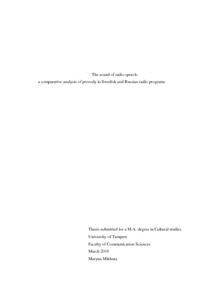The sound of radio speech : a comparative analysis of prosody in Swedish and Russian radio programs
Mikhuta, Maryna (2018)
Mikhuta, Maryna
2018
Master's Degree Programme in Cultural Studies
Viestintätieteiden tiedekunta - Faculty of Communication Sciences
This publication is copyrighted. You may download, display and print it for Your own personal use. Commercial use is prohibited.
Hyväksymispäivämäärä
2018-04-25
Julkaisun pysyvä osoite on
https://urn.fi/URN:NBN:fi:uta-201805041637
https://urn.fi/URN:NBN:fi:uta-201805041637
Tiivistelmä
Prosody plays an important role in human communication processes. Moreover, the results of researches in intonation are actively used in various fields, e.g. the development of speech production and speech recognition technologies, sound recording software creation, teaching first language to the hearing impaired, speech reconstruction after brain damaging conditions, teaching a foreign language, etc.
The research primarily examines phrase-level intonation patterns occurring in radio speech in Swedish and Russian. Within the study, radio represents the context. Radio programs were chosen as a source of data, since the recordings can provide high sound quality, and radio journalists are taught to speak clearly and actively use intonation patterns. The research comprises beginning parts of six programs in each language. Moreover, the programs were grouped into “serious” and “entertaining”.
The research is conducted within the post-structural methodology of the research prism combined with the theoretical views of Jakobson. The research is conducted on auditory and instrumental level, and includes the elements of literature review. The auditory level was conducted by the researcher herself, for the instrumental level sound analysis software Praat© was exploited. The key method within the study is visualization. On the auditory level visualization includes textual representation in written form, including a specially developed sign system. On the instrumental level visualization comprises software-created spectrograms and their textual description.
The results show some correlations between the topic of the radio program and the prosodic pattern used. In particular, the more emotional speech attributed to the “entertaining” programs exploits a wider pitch change range than the speech of the “serious” programs. However, the results are ambiguous and the issue deserves further studies including a bigger data sampling.
The research primarily examines phrase-level intonation patterns occurring in radio speech in Swedish and Russian. Within the study, radio represents the context. Radio programs were chosen as a source of data, since the recordings can provide high sound quality, and radio journalists are taught to speak clearly and actively use intonation patterns. The research comprises beginning parts of six programs in each language. Moreover, the programs were grouped into “serious” and “entertaining”.
The research is conducted within the post-structural methodology of the research prism combined with the theoretical views of Jakobson. The research is conducted on auditory and instrumental level, and includes the elements of literature review. The auditory level was conducted by the researcher herself, for the instrumental level sound analysis software Praat© was exploited. The key method within the study is visualization. On the auditory level visualization includes textual representation in written form, including a specially developed sign system. On the instrumental level visualization comprises software-created spectrograms and their textual description.
The results show some correlations between the topic of the radio program and the prosodic pattern used. In particular, the more emotional speech attributed to the “entertaining” programs exploits a wider pitch change range than the speech of the “serious” programs. However, the results are ambiguous and the issue deserves further studies including a bigger data sampling.
